Riley Bailey
Ukrainian forces conducted missile strikes on occupied Sevastopol, Crimea, on September 13, damaging a Russian landing ship, a Kilo class submarine, and port infrastructure. The Department of Strategic Communications of the Ukrainian Armed Forces stated that Ukrainian forces successfully conducted missile strikes on Russian naval means and port infrastructure in occupied Sevastopol.[1] Main Military Intelligence Directorate (GUR) Spokesperson Andriy Yusov stated that the missiles struck the Russian state-owned ship repair facility Sevmorzavod, damaging repair facilities as well as a landing ship and a submarine, both of which he described as unrecoverable.[2] The Russian Ministry of Defense (MoD) claimed that Russian air defenses intercepted seven out of 10 Ukrainian cruise missiles targeting the Sevmorzavod ship repair facility but acknowledged that Ukrainian missiles struck two ships under repair.[3] Geolocated footage published on September 13 shows explosions at the dry dock in the Sevastopol port.[4] Satellite imagery published on September 12 shows one Ropucha class landing ship and one Kilo class submarine at the dry dock, and satellite imagery published on September 13 shows that the Ukrainian missile strike likely destroyed the two vessels.[5] Ukrainian Southern Operational Command Spokesperson Captain First Rank Nataliya Humenyuk stated that there were no Russian missile carriers present during the strike but noted that Ukrainian intelligence is still unaware of which submarine was at the dry dock.[6] The apparent destruction of the two vessels will likely render the dry dock inoperable until Russian forces can clear the debris, which may take a significant amount of time. The extent of the damage to Sevmorzavod’s repair facilities beyond the dry dock is unclear, and any damage to one of the Russian Black Sea Fleet’s main repair facilities in occupied Crimea will likely have reverberating impacts in the event of further Ukrainian strikes on Russian naval assets.
Russian officials largely did not address the strike, while select Russian ultranationalists responded with predictable outrage. Crimean occupation officials claimed that the strikes damaged residential buildings and injured several dozen people, although they did not say whether the injured were Russian military personnel.[7] Prominent Kremlin propagandist Vladimir Solovyov expressed deep anger at the strike and called for retaliatory strikes on Western facilities that produced the alleged missiles that Ukraine used in the strike.[8] Solovyov’s call for escalation with the West is boilerplate rhetoric for his domestic audience but is not reflective of any actual Kremlin position on the matter. Russian milbloggers expressed concerns that the Ukrainian strike portends an intensification of Ukraine’s interdiction campaign targeting occupied Crimea.[9] One milblogger argued that Russian forces are unable to strike Ukrainian airfields at scale and that Russian military inaction allowed Ukrainian forces to sufficiently strengthen airfields against Russian strikes.[10]
Ukrainian forces advanced in western Zaporizhia Oblast and reportedly advanced near Bakhmut amid continued counteroffensive operations on both sectors of the front on September 13. Geolocated footage published on September 12 indicates that Ukrainian forces made limited gains south of Robotyne (12km south of Orikhiv) in western Zaporizhia Oblast.[11] The Ukrainian General Staff reported on September 13 that Ukrainian forces achieved unspecified partial successes near Robotyne as well as near Klishchiivka (7km southwest of Bakhmut), Andriivka (10km southwest of Bakhmut), and Kurdyumivka (13km southwest of Bakhmut) in the Bakhmut direction.[12]
Russian forces conducted a series of Shahed-131/136 drone strikes targeting Sumy and Odesa oblasts on the night of September 12 to 13. The Ukrainian General Staff reported that Ukrainian air defenses destroyed 34 of 45 Shaheds, which mainly targeted port infrastructure in Izmail and Reni, Odesa Oblast.[13] Odesa Oblast Administration Head Oleh Kiper reported that the drone strikes damaged the port and civilian infrastructure in Izmail Raion.[14] The Ukrainian Air Force reported that Russian forces launched the drones from occupied Cape Chauda in Crimea, Primorsko-Akhtarsk in Krasnodar Krai, and Kursk Oblast.[15]
Russian President Vladimir Putin is likely concerned that Russia’s growing relationship with North Korea may endanger Russia’s existing sanctions evasion schemes. Putin met with North Korean dictator Kim Jong Un at the Vostochny Cosmodrome in Amur Oblast on September 14.[16] Putin called the meeting “productive” and reported that he and Kim had a “frank exchange of views on the situation in the region and on bilateral relations.”[17] Putin also stated that Russia continues to comply with restrictions on military-technical cooperation with North Korea but noted that within the “framework of the current rules, there are opportunities.”[18] Putin is likely neutrally portraying his meeting with Kim in order to balance Russia’s interest in acquiring North Korean artillery munitions with concerns about the risk of triggering secondary international sanctions on Russia due to potential trade with North Korea amidst increased international scrutiny of Russian sanctions evasion.
The Russian MoD reportedly temporarily disrupted a Wagner Group force rotation to Syria amid reports of the Russian MoD’s ongoing efforts to subsume Wagner operations in Syria. A prominent Kremlin-affiliated milblogger amplified a claim on September 13 that the Russian MoD blocked Wagner forces from rotating personnel from Africa through the Hmeimim airbase in Latakia, Syria, prompting the Wagner forces to negotiate with the Syrian MoD to rotate through the Tiyas airbase in Homs Governorate instead.[19] The milblogger claimed that the Russian MoD used vehicles on the runway to prevent a Wagner plane from landing at the Tiyas airbase on September 12, and then deployed helicopters threatening to shoot down a Wagner plane. The milblogger claimed that the Wagner leadership in Syria contacted Russian Deputy Defense Minister Colonel General Yunus-Bek Yevkurov who allowed the plane to land.[20] Yevkurov’s reported involvement in this engagement as well as his recent trips to Africa continues to suggest that Russian Defense Minister Sergei Shoigu has likely appointed Yevkurov to oversee the MoD‘s effort to subsume the remnants of the Wagner Group.[21]
This reported Russian MoD-Wagner conflict in Syria suggests that elements of the Wagner Group may still have a cohesive leadership and that the MoD has deep concerns about the semi-independence of Wagner’s Syria contingent. Wagner’s ability to negotiate with senior Russian and Syrian MoD officials indicates that Wagner likely retains a cohesive-enough leadership to operate semi-independently of the Russian MoD. The Russian MoD’s decision to deny Wagner’s use of the Hmeimim airbase and disrupt the force rotation indicates that the MoD is likely concerned about Wagner’s insubordination toward the Russian military in Syria, though the precise concerns are unclear. The Wagner contingent in Syria may have better combat capabilities than Wagner contingents in other African states due to some combination of training, provisions, and organization. The MoD may also be concerned that the Syria Wagner contingent is more loyal to Prigozhin than the other Wagner arms. Syria is the only country in which the Wagner Group has a major contingent co-located with a major Russian MoD presence, and the Russian MoD detained Wagner commanders only in Syria and not elsewhere abroad following the June 24 rebellion.[22]
Key Takeaways:
- Ukrainian forces conducted missile strikes on occupied Sevastopol, Crimea, on September 13, damaging a Russian landing ship, a Kilo class submarine, and port infrastructure.
- Ukrainian forces advanced in western Zaporizhia Oblast and reportedly advanced near Bakhmut amid continued counteroffensive operations on both sectors of the front on September 13.
- Russian forces conducted a series of Shahed-131/136 drone strikes targeting Sumy and Odesa oblasts on the night of September 12 to 13.
- Russian President Vladimir Putin is likely concerned that Russia’s growing relationship with North Korea may endanger Russia’s existing sanctions evasion schemes.
- The Russian Ministry of Defense (MoD) reportedly temporarily disrupted a Wagner Group force rotation to Syria amid reports of the Russian MoD’s ongoing efforts to subsume Wagner operations in Syria.
- Russian forces conducted offensive operations along the Kupyansk-Svatove-Kreminna line, near Bakhmut, along the Avdiivka-Donetsk City line, in the western Donetsk-eastern Zaporizhia Oblast border area, and in western Zaporizhia Oblast but did not make any confirmed advances.
- Reports from Western and Russian independent sources indicate that Russia has circumvented some Western sanctions to increase weapons production but still struggles to produce weapons at the pace required by the war in Ukraine.
- The Ukrainian Main Military Intelligence Directorate (GUR) published footage showing GUR and Ukrainian partisans conducting a drone strike on a Russian occupation passportization office in occupied Enerhodar, Zaporizhia Oblast on September 12.
We do not report in detail on Russian war crimes because these activities are well-covered in Western media and do not directly affect the military operations we are assessing and forecasting. We will continue to evaluate and report on the effects of these criminal activities on the Ukrainian military and the Ukrainian population and specifically on combat in Ukrainian urban areas. We utterly condemn these Russian violations of the laws of armed conflict, Geneva Conventions, and humanity even though we do not describe them in these reports.
- Russian Main Effort – Eastern Ukraine (comprised of two subordinate main efforts)
- Russian Subordinate Main Effort #1 – Capture the remainder of Luhansk Oblast and push westward into eastern Kharkiv Oblast and encircle northern Donetsk Oblast
- Russian Subordinate Main Effort #2 – Capture the entirety of Donetsk Oblast
- Russian Supporting Effort – Southern Axis
- Russian Mobilization and Force Generation Efforts
- Activities in Russian-occupied areas
Russian Main Effort – Eastern Ukraine
Russian Subordinate Main Effort #1 – Luhansk Oblast (Russian objective: Capture the remainder of Luhansk Oblast and push westward into eastern Kharkiv Oblast and northern Donetsk Oblast)
Russian forces continued offensive operations along the Kupyansk-Svatove-Kreminna line but did not make any confirmed or claimed gains on September 13. The Ukrainian General Staff reported that Russian forces conducted an unsuccessful attack northwest of Berestove (20km northwest of Svatove).[23] A Russian news aggregator claimed that Russian forces conducted offensive operations near Synkivka (9km northeast of Kupyansk) and Petropavlivka (7km east of Kupyansk) on September 12.[24] A Russian milblogger claimed on September 13 that Russian forces conducted unsuccessful offensive operations west of Novoselivske (14km northwest of Svatove).[25] Chechen Republic Head Ramzan Kadyrov posted footage claiming to show Chechen “Akhmat” Spetsnaz forces operating in the Serebryanske forest area (11km south of Kreminna).[26] Another Russian milblogger posted footage on September 12 claiming to show elements of the Russian 21st Motorized Rifle Brigade (2nd Combined Arms Army, Central Military District) striking Ukrainian forces along the Svatove-Kreminna line.[27] The United Kingdom Ministry of Defense (UK MoD) reported on September 13 that elements of the Russian 25th Combined Arms Army (CAA) (reportedly formed under the Eastern Military District) have deployed to the frontline in Luhansk Oblast, supporting ISW’s previous reporting.[28] The Wall Street Journal (WSJ) also reported that Russian forces are regrouping and forming new assault units with personnel from the newly created 25th CAA in the Kupyansk direction.[29] The WSJ reported that the Russian military deployed 50,000 troops to retake Kupyansk but has had little success.[30] Ukrainian Kharkiv Oblast Head Oleh Synehubov reportedly stated that Russian forces have not captured a single new village in the Kupyansk direction since 2022 but have only expanded the contested “gray zone” around a number of settlements.[31]
Ukrainian forces reportedly conducted ground attacks along the Kupyansk-Svatove-Kreminna line on September 13 but did not make any claimed or confirmed gains. A Russian milblogger claimed that fighting continues on the outskirts of Kupyansk – likely referring to the area near Synkivka and Petropavlivka - and that Ukrainian forces are counterattacking from the settlement’s flanks in order to avoid Russian encirclement.[32] ISW has not observed visual evidence of Russian advances close enough to Kupyansk to necessitate Ukrainian concerns about encirclement. Russian sources, including the Russian MoD, claimed on September 12 and 13 that Ukrainian forces conducted unsuccessful attacks near Yampolivka (17km west of Kreminna), Torske (14km west of Kreminna), Dibrova (7km southwest of Kreminna), and the Serebryanske forest area.[33]
Russian Subordinate Main Effort #2 – Donetsk Oblast (Russian objective: Capture the entirety of Donetsk Oblast, the claimed territory of Russia’s proxies in Donbas)
Ukrainian forces continued counteroffensive operations around Bakhmut and reportedly advanced on September 13. The Ukrainian General Staff reported that Ukrainian forces continued offensive operations in the Bakhmut direction and achieved unspecified partial successes near Klishchiivka (7km southwest of Bakhmut), Andriivka (10km southwest of Bakhmut), and Kurdyumivka (13km southwest of Bakhmut).[34] A Russian milblogger claimed that Russian forces withdrew from several unspecified positions near Klishchiivka and entrenched themselves at defensive positions behind the railway line east of the settlement.[35] Russian milbloggers claimed that fighting is ongoing in and north of Klishchiivka and that Russian forces maintain positions on the northeastern outskirts of the settlement.[36] Russian milbloggers claimed that most of Klishchiivka is currently a contested “gray zone.”[37]
Russian forces counterattacked in the Bakhmut area on September 13 but did not make any confirmed gains. The Ukrainian General Staff reported that Russian forces conducted unsuccessful offensive actions near Orikhovo-Vasylivka (11km northwest of Bakhmut) and Bohdanivka (7km northwest of Bakhmut).[38] A prominent Russian milblogger claimed that Russian forces conducted successful counterattacks near Klishchiivka and pushed Ukrainian forces out of the settlement but that heavy Ukrainian artillery fire is preventing Russian forces from reestablishing their positions in central and southern Klishchiivka.[39] ISW has not observed visual confirmation that Ukrainian forces have left positions in Klishchiivka, however. The milblogger also claimed that there are conflicting reports that Russian forces completely recaptured Andriivka, and a Russian news aggregator claimed that the settlement is contested.[40]
The Russian MOD claimed that Russian forces repelled Ukrainian assaults near Pervomaiske (12km southwest of Avdiivka) and Krasnohorivka (22km southwest of Avdiivka) along the Avdiivka-Donetsk City front on September 13.[41]
Russian forces continued limited ground attacks along the Avdiivka-Donetsk City front on September 13 but did not advance. The Ukrainian General Staff reported that Russian forces conducted unsuccessful offensive actions near Avdiivka, Marinka (27km southwest of Avdiivka), and Novomykhailivka (36km southwest of Avdiivka).[42] A Russian milblogger also claimed that Russian assaults near Avdiivka were unsuccessful.[43]
Russian Supporting Effort – Southern Axis (Russian objective: Maintain frontline positions and secure rear areas against Ukrainian strikes)
Ukrainian forces reportedly conducted offensive operations in the western Donetsk-eastern Zaporizhia Oblast border area on September 13 but did not make any confirmed advances. The Russian MoD and other Russian sources claimed that Russian forces repelled Ukrainian attacks along the Novodonetske-Novomayorske line (13–18km southeast of Velyka Novosilka) and near Pryyutne (16km southwest of Velyka Novosilka).[44]
Russian forces conducted offensive operations in the western Donetsk-eastern Zaporizhia Oblast border area on September 13 but did not advance. The Ukrainian General Staff reported that Russian forces unsuccessfully attacked south of Novodarivka (13km southwest of Velyka Novosilka).[45] A Russian milblogger claimed that Russian forces hold recently occupied positions near Pryyutne.[46] Footage published on September 12 purportedly shows snipers of the Russian 5th Tank Brigade (36th Combined Arms Army, Eastern Military District) operating in the Velyka Novosilka area.[47]
Ukrainian forces conducted offensive operations in western Zaporizhia Oblast on September 13 and advanced. Geolocated footage published on September 12 shows that Ukrainian forces made limited gains south of Robotyne (12km south of Orikhiv).[48] The Ukrainian General Staff reported that Ukrainian forces achieved partial success near Robotyne.[49] The Russian MoD and other Russian sources claimed that Russian forces repelled Ukrainian attacks near Verbove (18km southwest of Orikhiv) and in the area between Robotyne and Verbove.[50] A Russian milblogger claimed that most of Robotyne is contested and that Russian forces maintain positions near the southern outskirts of the settlement.[51] A Russian milblogger claimed on September 12 that Ukrainian forces attacked west of Robotyne in the direction of Kopani (12km southwest of Orikhiv).[52]
Russian forces conducted offensive operations in western Zaporizhia Oblast on September 13 but did not advance. Russian milbloggers claimed that Russian forces attacked Ukrainian positions southwest of Robotyne and that fighting is ongoing on the outskirts of Novoprokopivka (18km southeast of Orikhiv) and Verbove.[53] A Russian news aggregator claimed that Russian forces regularly counterattack in the area between Robotyne and Verbove in order to prevent Ukrainian forces from advancing.[54] Footage posted on September 13 purportedly shows elements of the Russian 7th Guards Mountain Airborne (VDV) Division operating near Verbove.[55]
Ukrainian Melitopol Mayor Ivan Fedorov reported on September 13 that Russian forces are strengthening defensive positions in occupied Zaporizhia Oblast. Fedorov stated that Russian forces are setting up new unspecified equipment and dragon’s teeth anti-tank fortifications near Tokmak and digging new trenches and strengthening defensive structures near the frontline in Polohivskyi Raion.[56]
A Russian source claimed on September 13 that Ukrainian forces continue operations on islands in the Dnipro River delta in Kherson Oblast. A Russian milblogger claimed that battles for unspecified islands in the Dnipro River are ongoing, and that Ukrainian forces have entrenched themselves on some unspecified islands and maintain positions near the Antonivsky Bridge in the east (left) bank of Kherson Oblast.[57] Footage published on September 13 purportedly shows artillery elements of the 205th Motorized Rifle Brigade (49th Combined Arms Army, Southern Military District) striking Ukrainian forces near Kherson City.[58]
Russian Mobilization and Force Generation Efforts (Russian objective: Expand combat power without conducting general mobilization)
Reports from Western and Russian independent sources indicate that Russia has circumvented some Western sanctions to increase weapons production but still struggles to produce weapons at the pace required by the war in Ukraine. The New York Times (NYT) cited US, European, and Ukrainian officials as stating that Russia has increased its missile and weapons production beyond its pre-war production levels despite Western sanctions.[59] The officials reportedly stated that Russia’s defense industrial base (DIB) began increasing production at the end of 2022 and can now produce up to 200 tanks per year, double its prewar production of 100 tanks per year.[60] The officials also reportedly stated that Russia has cut costs in artillery ammunition production by sacrificing safety and quality.[61] Russian independent outlet Novaya Gazeta reported however that at least 419 Russian DIB enterprises failed to meet the parameters of the Russian state defense order resulting in over 400 criminal cases since the start of the full-scale invasion, including 79 cases on activity at the Zvezdochka ship repair center, 39 cases at the Instrument Design Bureau (KBP), 34 cases at the “Progress” Rocket-Space Center, 22 cases at the Sevmash facility, and 20 cases at Uralvagonzavod.[62] Novaya Gazeta also reported that the number of vacancies in Russian DIB enterprises has increased by 48 percent since September 2022.[63]
Some Russian authorities are increasingly seeking terms for demobilization and other measures supporting Russian military personnel mobilized during the autumn 2022 partial mobilization. Tatarstan Republic Council Deputy Head Eduard Sharafiev stated on September 13 that he submitted a preliminary proposal to the Russian Federation Council of Legislators to amend the Russian partial mobilization order to establish terms for demobilizing personnel mobilized in autumn 2022.[64] The Council of Legislators has reportedly sent the proposed amendment to the State Duma Defense Committee for consideration.[65] Russian State Duma Deputy Maxim Ivanov stated on September 13 that the current mechanisms for granting leave to mobilized personnel are unclear, unregulated, and strongly dependent on the situation on the front line and the decision of the commander.[66]
Russian authorities imposed new standards for Russian military recruitment and treatment of recruits likely in connection with the upcoming autumn conscription cycle. Russian Defense Minister Sergei Shoigu signed a decree on September 13 preventing Russians who are otherwise “partially fit” for military service from serving under mobilization or contracts during periods of martial law, mobilization, or wartime.[67] The decree stipulates that Russians with HIV, Hepatitis B and C, various active tuberculosis variants, malignant cancers, Type 1 diabetes, a history of strokes, vision impairments, and other medical conditions may not serve in these conditions.[68] The Russian MoD published a decree on September 13 dated September 11 that stipulates the payment of pensions to Russian mobilized and contracted personnel who received pensions prior to serving in the Russian military and began serving after the start of the war in Ukraine.[69] The decree stipulates that the MoD will pay these pensioners monthly beginning in October 2023 and compensate the pensioners for pensions not received after they entered military service and stopped receiving pensions.[70]
Activities in Russian-occupied areas (Russian objective: Consolidate administrative control of annexed areas; forcibly integrate Ukrainian citizens into Russian sociocultural, economic, military, and governance systems)
The Ukrainian Main Military Intelligence Directorate (GUR) published footage showing GUR and Ukrainian partisans conducting a drone strike on a Russian occupation passportization office in occupied Enerhodar, Zaporizhia Oblast on September 12.[71] GUR reported that the drone strike caused a fire at the passportization office and that GUR and the Ukrainian partisans also struck a Russian radio communication posit in Enerhodar.[72]
Russian President Vladimir Putin submitted an amendment to the law on “the Days of Military Glory and Memorable Dates of Russia” on September 12 that will establish September 30 as the “Day of Reunification” for occupied Kherson, Zaporizhia, Donetsk, and Luhansk oblasts.[73] Russian occupation officials will likely use the holiday to amplify programs aimed at consolidating social control over occupied territories in Ukraine.
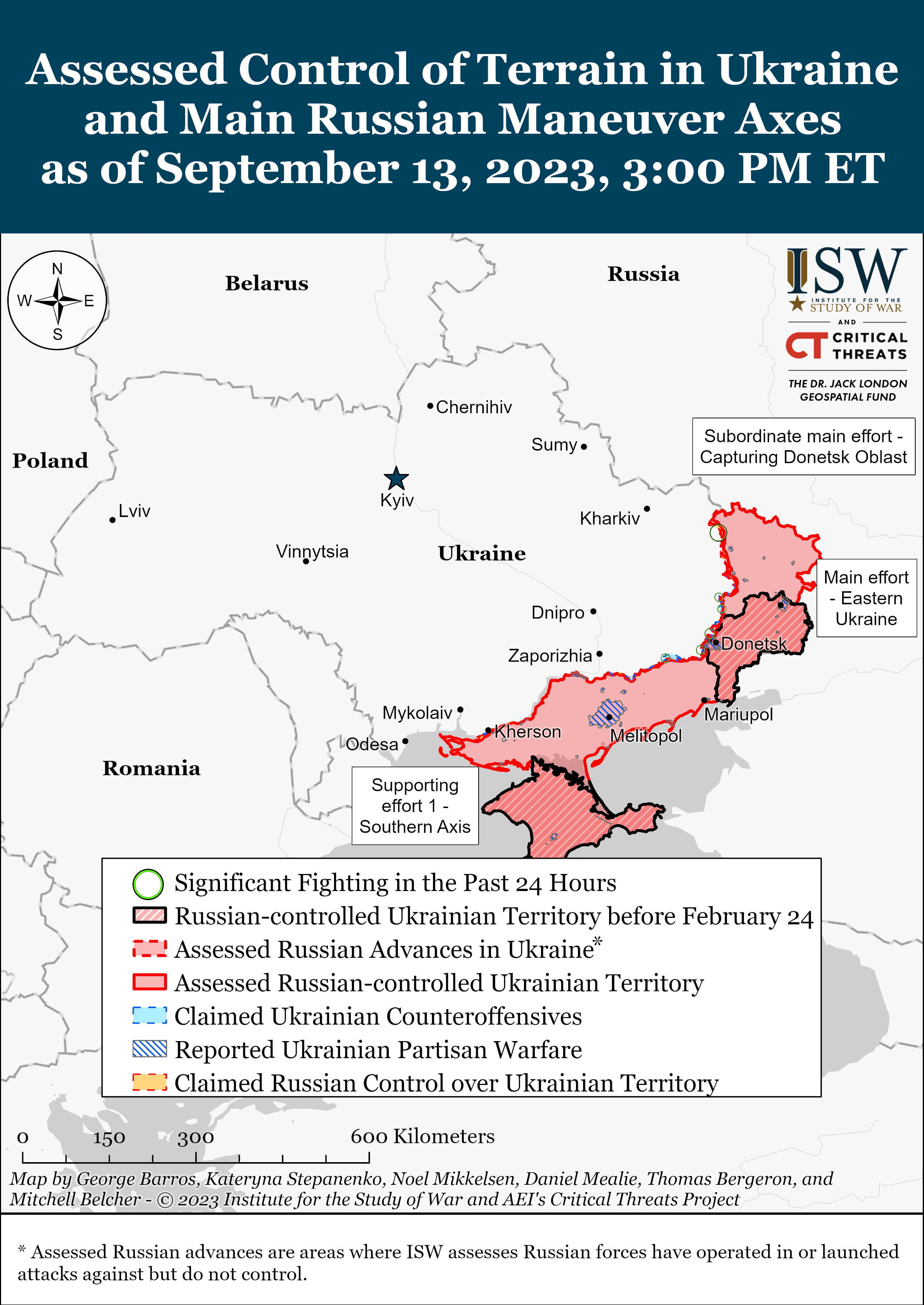
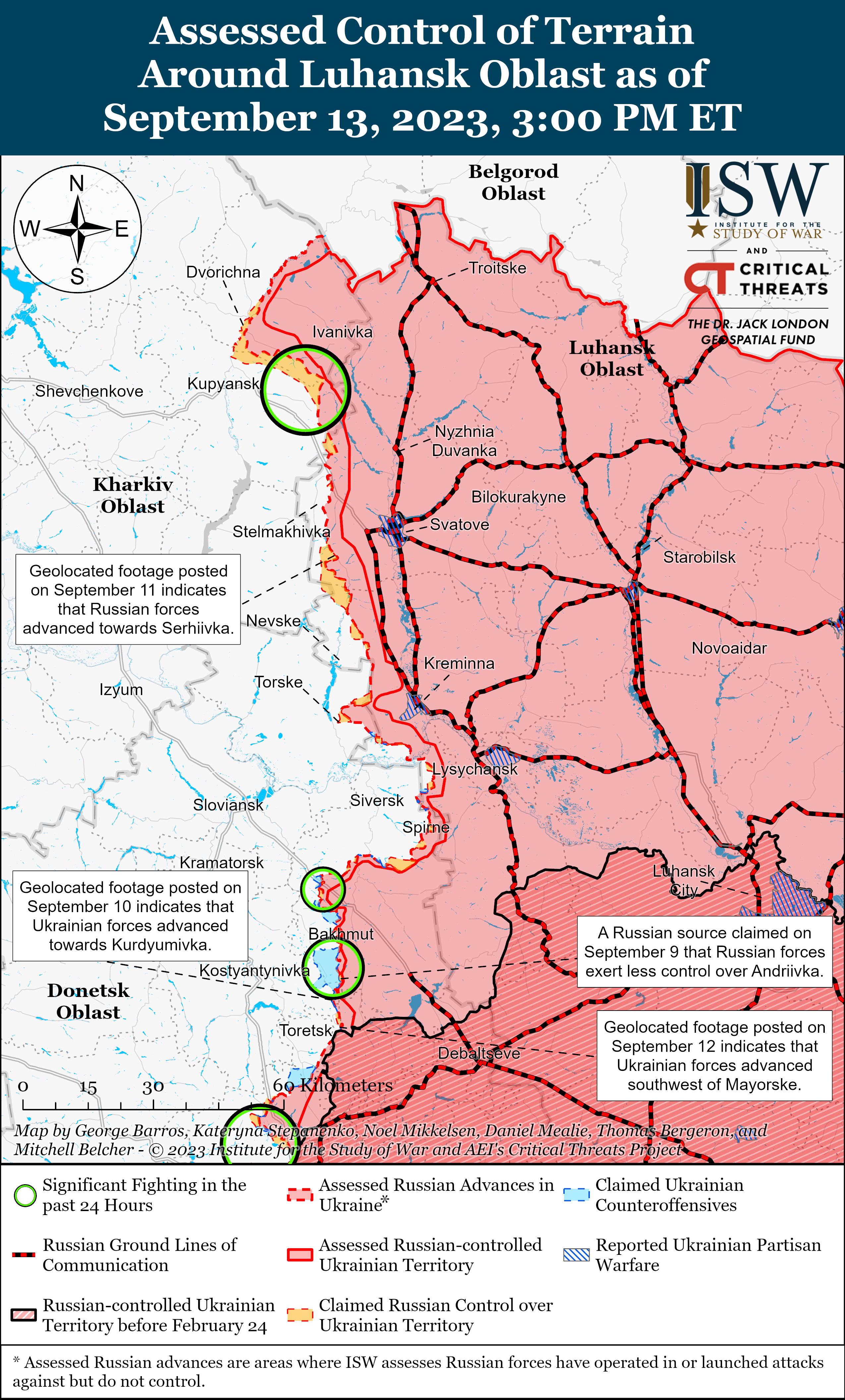
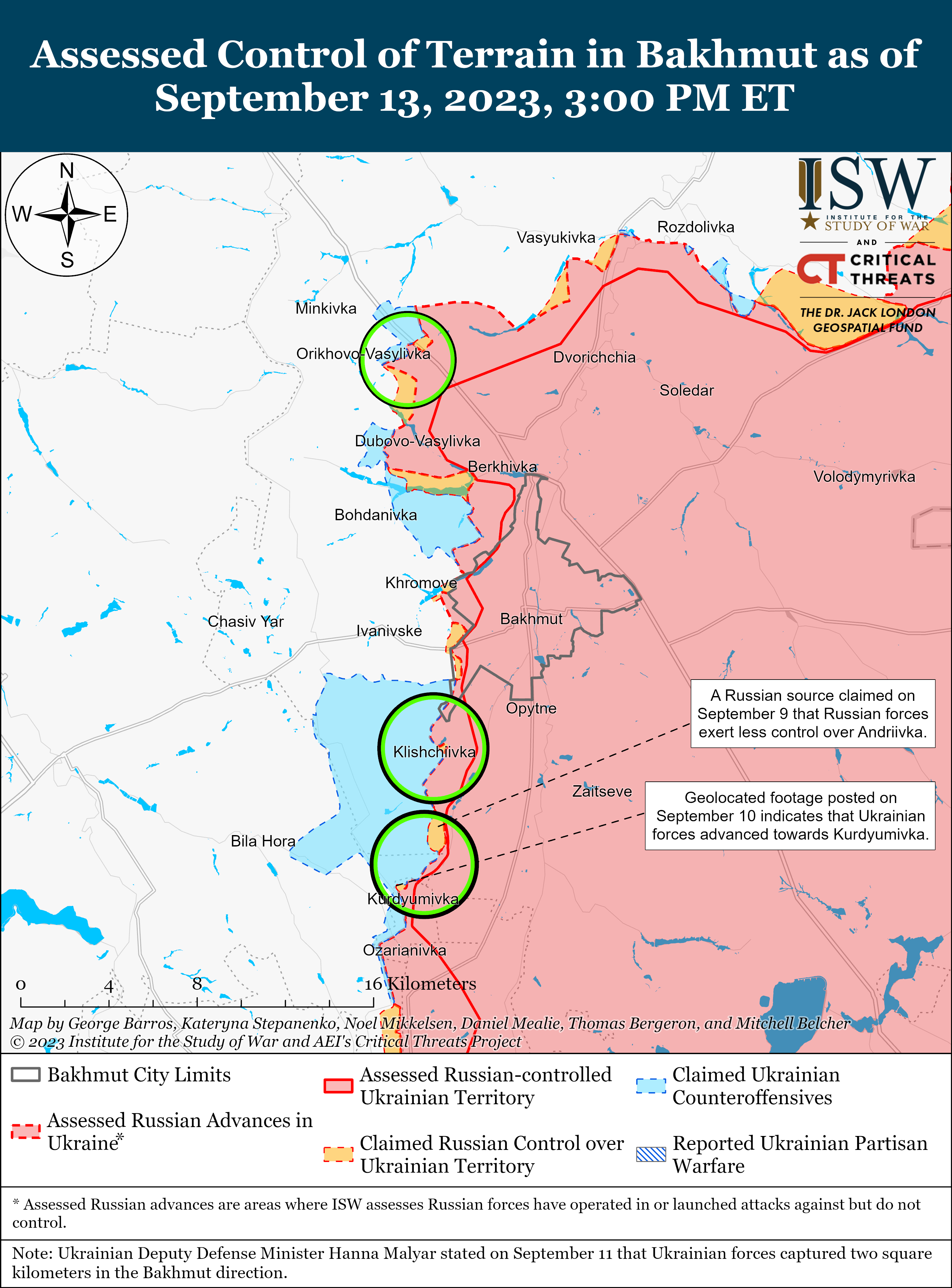
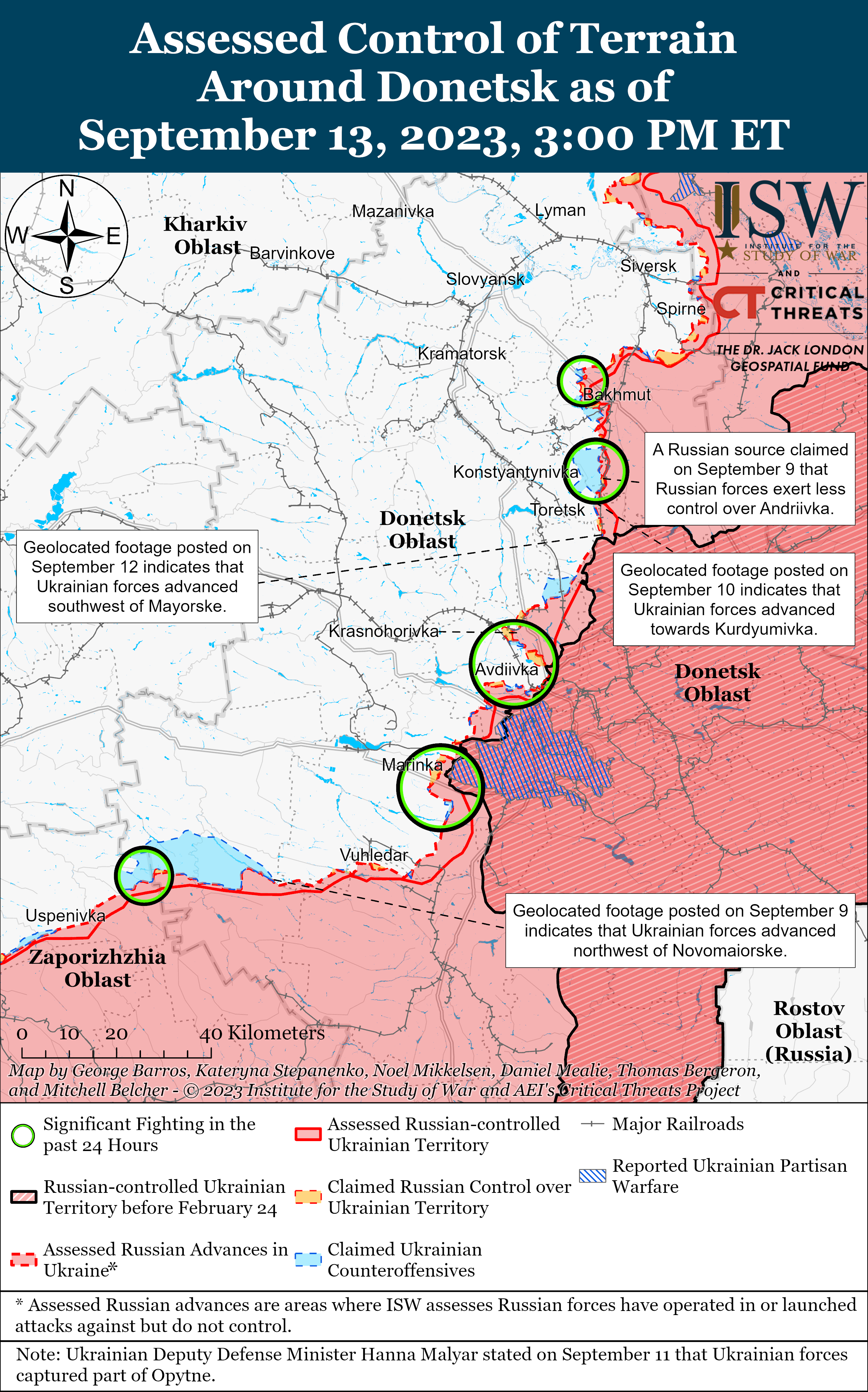
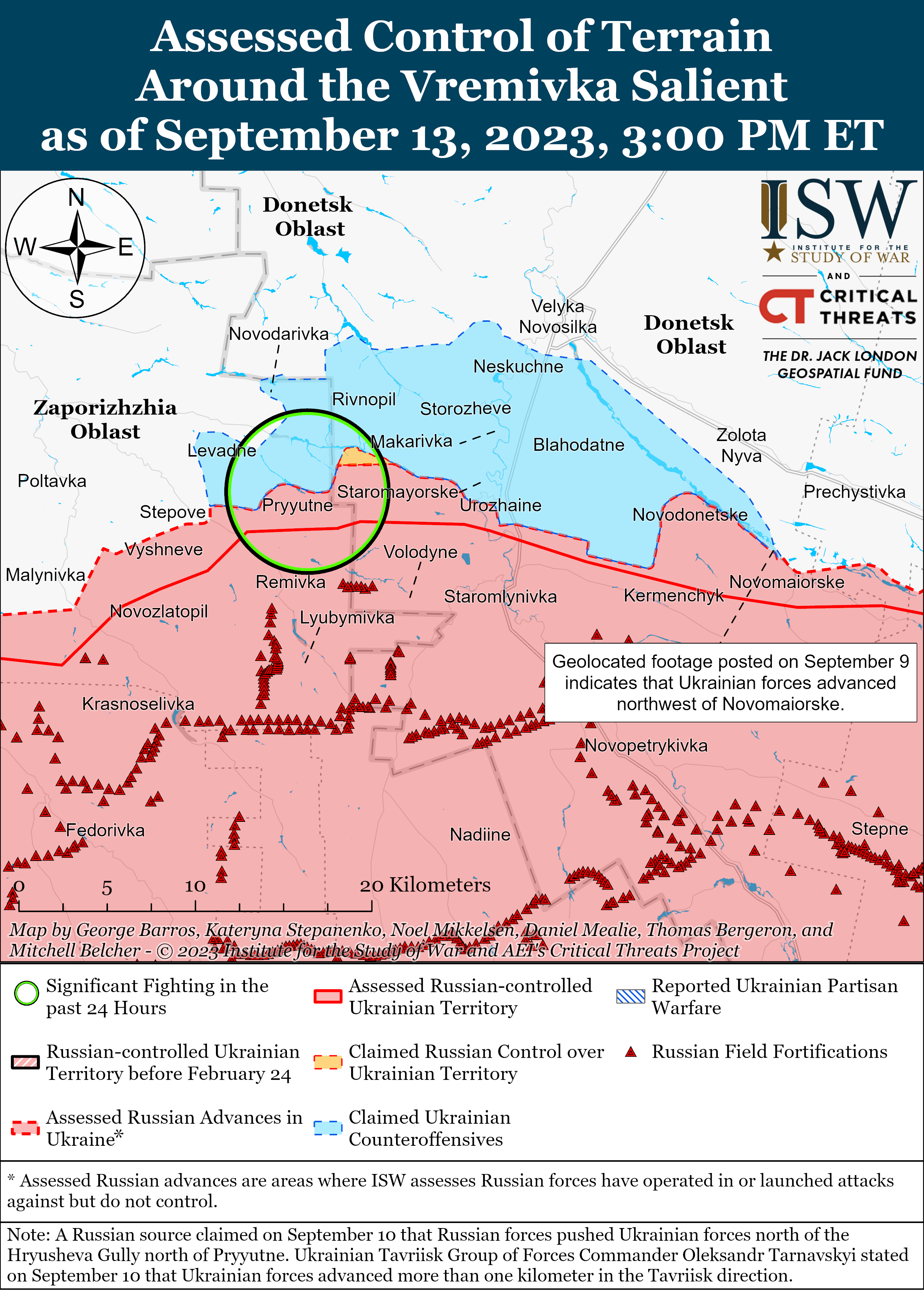
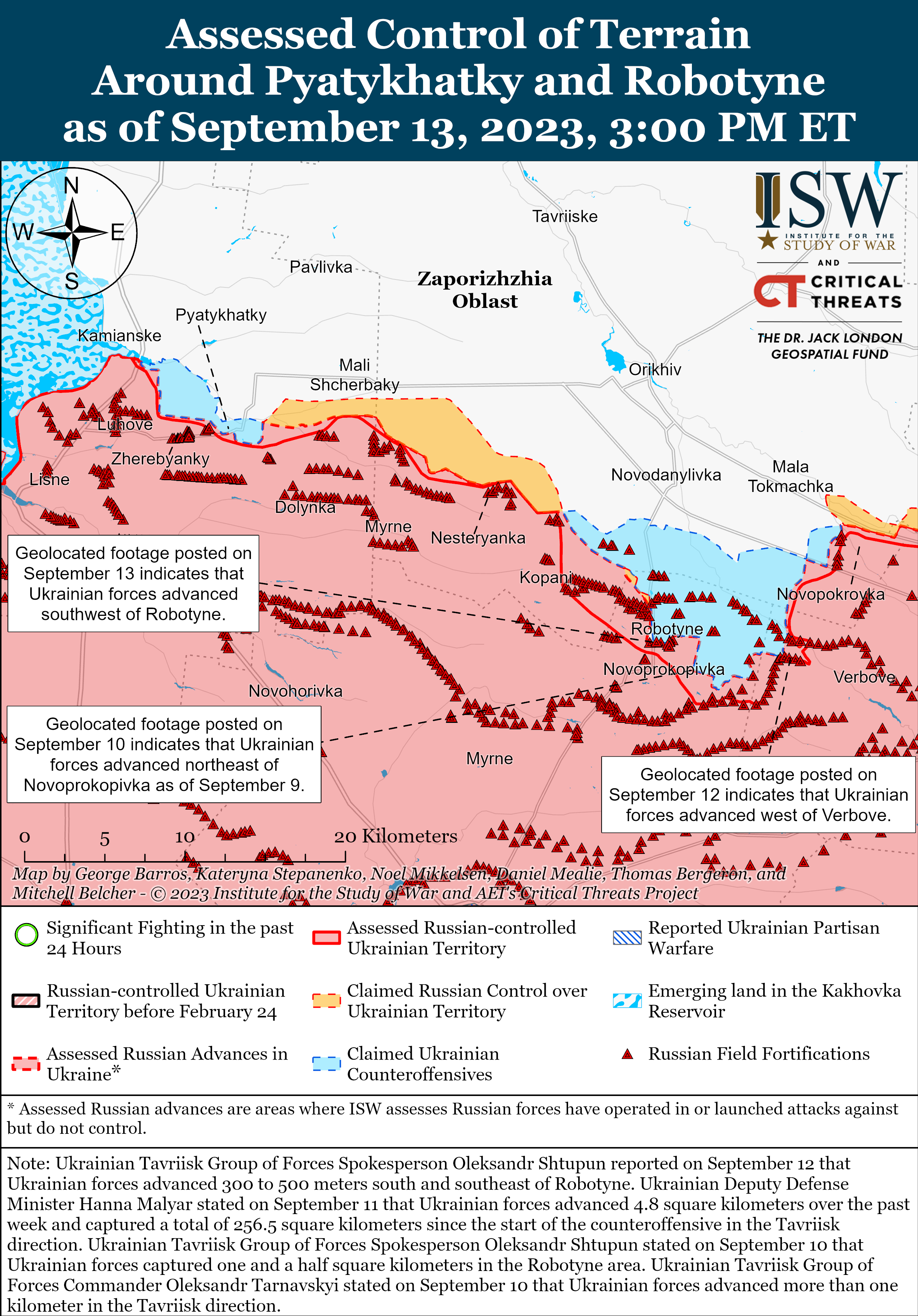
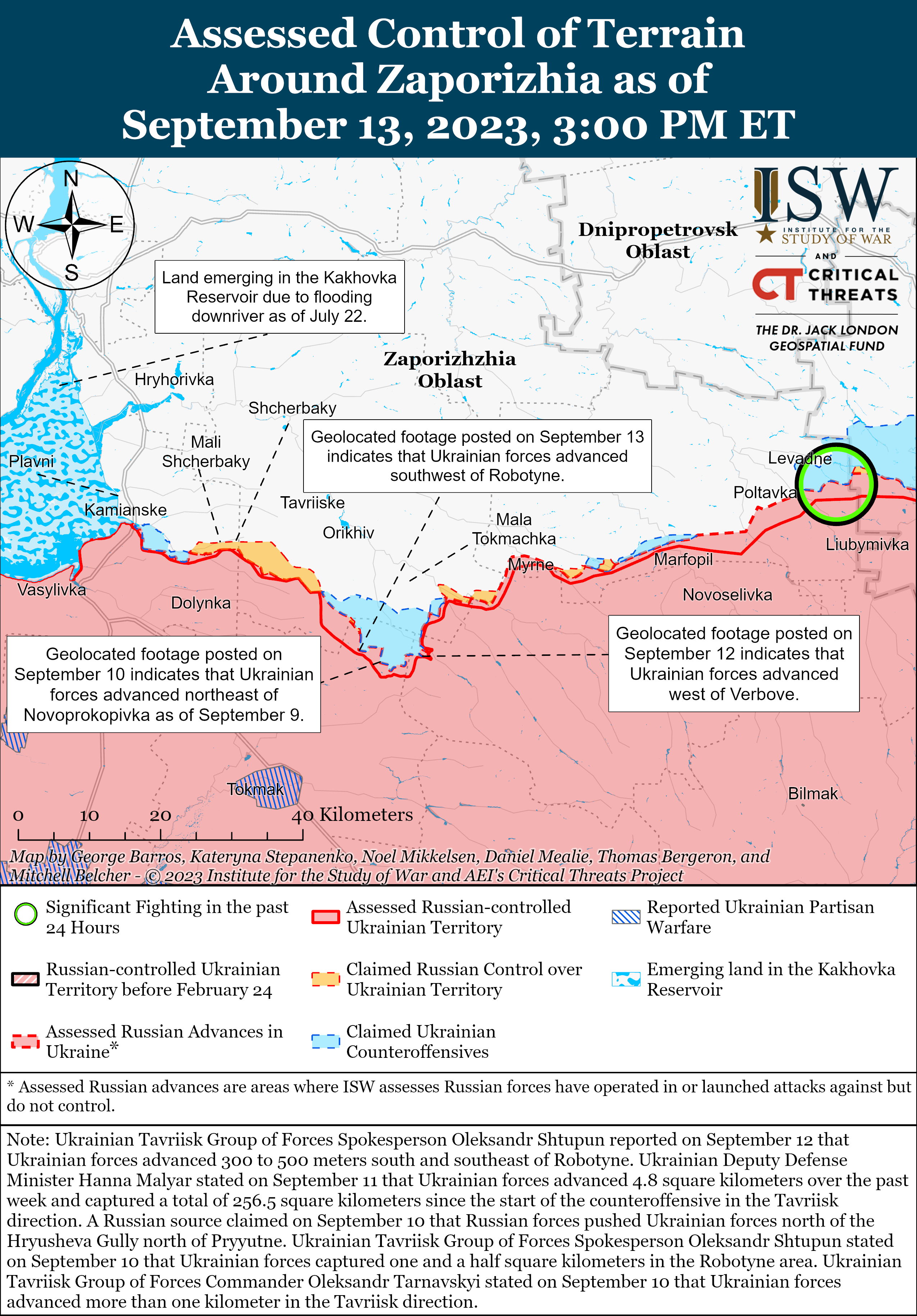
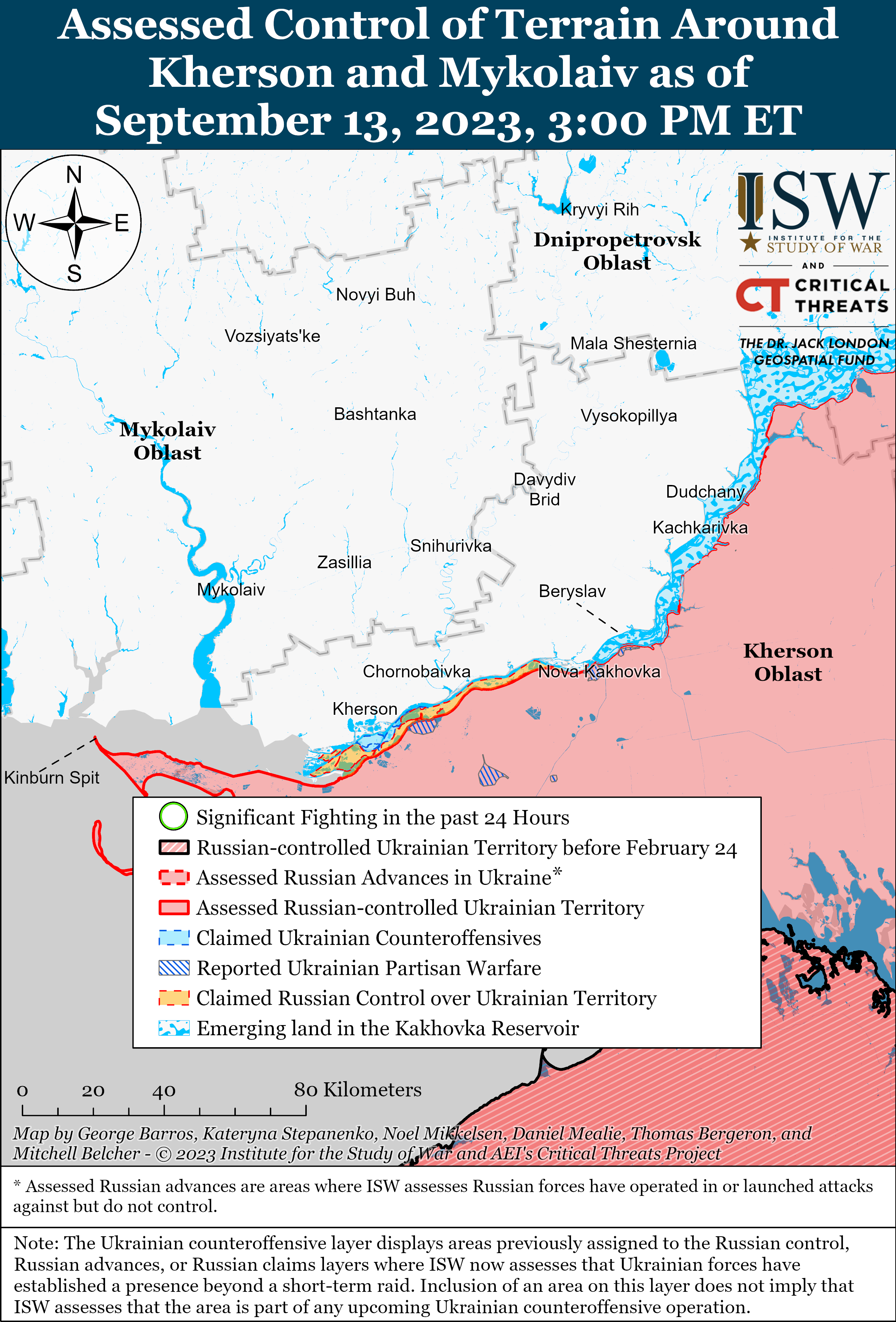
No comments:
Post a Comment